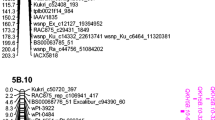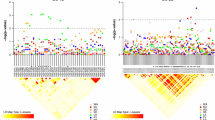Abstract
Kernel hardness or texture, used to classify wheat (Triticum aestivum L.) into soft and hard classes, is a major determinant of milling and baking quality. Wheat genotypes in the soft class that are termed ‘extra-soft’ (with kernel hardness in the lower end of the spectrum) have been associated with superior end-use quality. In order to better understand the relationship between kernel hardness, milling yield, and various agronomic traits, we performed quantitative trait mapping using a recombinant inbred line population derived from a cross between a common soft wheat line and a genotype classified as an ‘extra-soft’ line. A total of 47 significant quantitative trait loci (QTL) (LOD ≥ 3.0) were identified for nine traits with the number of QTL affecting each trait ranging from three to nine. The percentage of phenotypic variance explained by these QTL ranged from 3.7 to 50.3%. Six QTL associated with kernel hardness and break flour yield were detected on chromosomes 1BS, 4BS, 5BS, 2DS, 4DS, and 5DL. The two most important QTL were mapped onto orthologous regions on chromosomes 4DS (Xbarc1118–Rht-D1) and 4BS (Xwmc617–Rht-B1). These results indicated that the ‘extra-soft’ characteristic was not controlled by the Hardness (Ha) locus on chromosome 5DS. QTL for eight agronomic traits occupied two genomic regions near semi-dwarf genes Rht-D1 on chromosome 4DS and Rht-B1 on chromosome 4BS. The clustering of these QTL is either due to the pleiotropic effects of single genes or tight linkage of genes controlling these various traits.




Similar content being viewed by others
References
Beecher B, Bettge A, Smidansky E, Giroux M (2002) Expression of wild-type pinB sequence in transgenic wheat complements a hard phenotype. Theor Appl Genet 105:870–877
Bergman CJ, Gualberto DG, Campbell KG, Sorrells ME, Finney PL (1998) Genotype and environment effects on wheat quality traits in a population derived from a soft by hard cross. Cereal Chem 75:729–737
Borner A, Schumann E, Furste A, Coster H, Leithold B, Roder MS, Weber WE (2002) Mapping of quantitative trait loci determining agronomic important characters in hexaploid wheat (Triticum aestivum L.). Theor Appl Genet 105:921–936
Börner A, Röder M, Korzun V (1997) Comparative molecular mapping of GA insensitive Rht loci on chromosomes 4B and 4D of common wheat (Triticum aestivum L.). Theor Appl Genet 95:1133–1137
Breseghello F, Finney PL, Gaines C, Andrews L, Tanaka J, Penner G, Sorrells ME (2005) Genetic loci related to kernel quality differences between a soft and a hard wheat cultivar. Crop Sci 45:1685–1695
Campbell KG, Bergman CJ, Gualberto DG, Anderson JA, Giroux MJ, Hareland G, Fulcher RG, Sorrells ME, Finney PL (1999) Quantitative trait loci associated with kernel traits in a soft × hard wheat cross. Crop Sci 39:1184–1195
Chen XM, Line RF (1995) Gene action in wheat cultivars for durable, high-temperature, adult-plant resistance and interaction with race-specific, seedling resistance to Puccinia striiformis. Phytopathology 85:567–572
Christopher MJ, Butler D, Rodgers D, Mace ES, Martin D, McGowan P, Jordan D, Shatte T, Jennings R, DeLacy I (2008) Flour yield and water absorption in wheat-a pedigree mapping approach. In: Appels R et al (ed) Sydney University Press
Collard BCY, Grams RA, Bovill WD, Percy CD, Jolley R, Lehmensiek A, Wildermuth G, Sutherland MW (2005) Development of molecular markers for crown rot resistance in wheat: mapping of QTLs for seedling resistance in a ‘2–49’ × ‘Janz’ population. Plant Breed 124:532–537
Ellis MH, Spielmeyer W, Gale KR, Rebetzke GJ, Richards RA (2002) “Perfect” markers for the Rht-B1b and Rht-D1b dwarfing genes in wheat. Theor Appl Genet 105:1038–1042
Fu D, Szucs P, Yan L, Helguera M, Skinner JS, von Zitzewitz J, Hayes PM, Dubcovsky J (2005) Large deletions within the first intron in VRN-1 are associated with spring growth habit in barley and wheat. Mol Genet Genomics 273:54–65
Gaines CS (1985) Associations among soft wheat flour particle size, protein content, chlorine response, kernel hardness, milling quality, white layer cake volume, and sugar-snap cookie spread. Cereal Chem 62:290–292
Giroux MJ, Morris CF (1998) Wheat grain hardness results from highly conserved mutations in the friabilin components puroindoline a and b. Proc Natl Acad Sci USA 95:6262–6266
Greenwell P, Schofield JD (1986) A starch granule protein associated with endosperm softness in wheat. Cereal Chem 63:379–380
Groos C, Robert N, Bervas E, Charmet G (2003) Genetic analysis of grain protein-content, grain yield and thousand-kernel weight in bread wheat. Theor Appl Genet 106:1032–1040
Hogg AC, Sripo T, Beecher B, Martin JM, Giroux MJ (2004) Wheat puroindolines interact to form friabilin and control wheat grain hardness. Theor Appl Genet 108:1089–1097
Hoogendoorn J (1985) A reciprocal F1 analysis of the genetic control of the time of ear emergence, number of leaves and number of spikelets in wheat (Triticum aestivum L.). Euphytica 34:545–558
Huang XQ, Kempf H, Ganal MW, Röder MS (2004) Advanced backcross QTL analysis in progenies derived from a cross between a German elite winter wheat variety and a synthetic wheat (Triticum aestivum L.). Theor Appl Genet 109:933–943
Jolly CJ, Glenn GM, Rahman S (1996) GSP-1 genes are linked to the grain hardness locus (Ha) on wheat chromosome 5D. Proc Natl Acad Sci USA 93:2408–2413
Joppa LR, Du C, Hart GE, Hareland GA (1997) Mapping gene(s) for grain protein in tetraploid wheat (Triticum turgidum L.) using a population of recombinant inbred chromosome lines. Crop Sci 37:1586–1589
Khan IA, Procunier JD, Humphreys DG, Tranquilli G, Schlatter AR, Marcucci-Poltri S, Frohberg RC, Dubcovsky J (2000) Development of PCR-based markers for a high grain protein content gene from Triticum turgidum ssp. dicoccoides transferred to bread wheat. Crop Sci 40:518–524
Kim W, Johnson J, Baenziger P, Lukaszewski A, Gaines C (2004) Agronomic effect of wheat-rye translocation carrying rye chromatin (1R) from different sources. Crop Sci 44:1254–1258
Li Y, Song Y, Zhou R, Branlard G, Jia J (2009) Detection of QTLs for bread-making quality in wheat using a recombinant inbred line population. Plant Breed 128:235–243
Mattern PJ, Morris R, Schmidt JW, Johnson VA (1973) Location of genes for kernel properties in the wheat variety ‘Cheyenne’ using chromosome substitution lines. In: Proceedings of the 4th International Wheat Genetics Symposium, Columbia, pp 703–708
McCartney CA, Somers DJ, Lukow O, Ames N, Noll J, Cloutier S, Humphreys DG, McCallum BD (2006) QTL analysis of quality traits in the spring wheat cross RL4452 בAC Domain’. Plant Breed 125:565–575
Moreno-Sevilla B, Baenziger PS, Peterson CJ, Graybosch RA, McVey DV (1995) The 1BL/1RS translocation: agronomic performance of F3-derived lines from a winter wheat cross. Crop Sci 35:1051–1055
Narasimhamoorthy B, Gill BS, Fritz AK, Nelson JC, Brown-Guedira GL (2006) Advanced backcross QTL analysis of a hard winter wheat × synthetic wheat population. Theor Appl Genet 112:787–796
Nelson JC, Andreescu C, Breseghello F, Finney PL, Gualberto DG, Bergman CJ, Peña RJ, Perretant MR, Leroy P, Qualset CO (2006) Quantitative trait locus analysis of wheat quality traits. Euphytica 149:145–159
Parker GD, Chalmers KJ, Rathjen AJ, Langridge P (1999) Mapping loci associated with milling yield in wheat (Triticum aestivum L.). Mol Breed 5:561–568
Richards RA (1992) The effect of dwarfing genes in spring wheat in dry environments. I. Agronomic characteristics. Aust J Agric Res 43:517–527
Riera-Lizarazu O, Peterson CJ, Wang G, Leonard JM (2010) Registration of the OS9 × Q36 mapping population of wheat (Triticum aestivum L.). J Plant Regist 4:98–104
Schmidt AL, Liu CJ, Martin D, Kelly A, McIntyre L (2004) Molecular markers for selected quality traits in Australian hexaploid bread wheat. In: Proceedings of the 4th International Crop Science Congress, Brisbane
Singh RP, Huerta-Espino J, Rajaram S, Crossa J (2001) Grain yield and other traits of tall and dwarf isolines of modern bread and durum wheats. Euphytica 119:241–244
Snape JW, Foulkes MJ, Simmonds J, Leverington M, Fish LJ, Wang Y, Ciavarrella M (2007) Dissecting gene × environmental effects on wheat yields via QTL and physiological analysis. Euphytica 154:401–408
Somers DJ, Isaac P, Edwards K (2004) A high-density microsatellite consensus map for bread wheat (Triticum aestivum L.). Theor Appl Genet 109:1105–1114
Sourdille P, Perretant MR, Charmet G, Leroy P, Gautier MF, Joudrier P, Nelson JC, Sorrells ME, Bernard M (1996) Linkage between RFLP markers and genes affecting kernel hardness in wheat. Theor Appl Genet 93:580–586
Sourdille P, Snape JW, Cadalen T, Charmet G, Nakata N, Bernard S, Bernard M (2000) Detection of QTLs for heading time and photoperiod response in wheat using a doubled-haploid population. Genome 43:487–494
Spielmeyer W, Hyles J, Joaquim P, Azanza F, Bonnett D, Ellis ME, Moore C, Richards RA (2007) A QTL on chromosome 6A in bread wheat (Triticum aestivum) is associated with longer coleoptiles, greater seedling vigour and final plant height. Theor Appl Genet 115:59–66
Van Ooijen JW (2004) MapQTL® 5, Software for the mapping of quantitative trait loci in experimental populations. Kyazma BV, Wageningen
Van Ooijen JW (2006) JoinMap 4.0, Software for the calculation of genetic linkage maps in experimental populations. Wageningen
Voorrips RE (2002) MapChart: software for the graphical presentation of linkage maps and QTLs. J Hered 93:77–78
Wallwork H, Butt M, Cheong JPE, Williams KJ (2004) Resistance to crown rot in wheat identified through an improved method for screening adult plants. Aust Plant Pathol 33:1–7
Yamazaki WT, Donelson JR (1983) Kernel hardness of some US wheats. Cereal Chem 60:344–350
Zanetti S, Winzeler M, Feuillet C, Keller B, Messmer M (2001) Genetic analysis of bread-making quality in wheat and spelt. Plant Breed 120:13–19
Acknowledgments
We would like to thank Dr. C. F. Morris for providing access to the milling facilities at the USDA-ARS Western Wheat Quality Lab (Pullman, WA). Financial support from the National Research Initiative of the USDA-Coordinate State Research, Education and Extension Service (Coordinate Agricultural Project (CAP) grant number 2006-55606-16629), Oregon State University Agricultural Research Foundation, Oregon Agricultural Experiment Station, and the Oregon Wheat Commission, is greatly appreciated (All the above grants were awarded to Dr. Oscar Riera-Lizarazu while he was a faculty at Oregon State University).
Author information
Authors and Affiliations
Corresponding author
Additional information
Communicated by Y. Xu.
Electronic supplementary material
Below is the link to the electronic supplementary material.
Rights and permissions
About this article
Cite this article
Wang, G., Leonard, J.M., Ross, A.S. et al. Identification of genetic factors controlling kernel hardness and related traits in a recombinant inbred population derived from a soft × ‘extra-soft’ wheat (Triticum aestivum L.) cross. Theor Appl Genet 124, 207–221 (2012). https://doi.org/10.1007/s00122-011-1699-0
Received:
Accepted:
Published:
Issue Date:
DOI: https://doi.org/10.1007/s00122-011-1699-0




